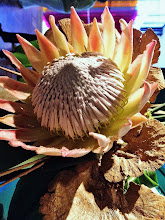Exquisitely delightful, beautifully dainty...everything BUT the voices! There was nothing dainty about those, even the countertenor's.
The 4 'ladies of the night' sung superbly.
Susan Graham (a clear, wide ranged mezzo) easily believable in the trouserrole of Xerxes without a beard (lol), is placed opposite David Daniels (countertenor, with a beard) as Arsamenes, her brother, both with flowing locks, both enamored of Romilda, sung delightfully by Soprano Laura Claycomb who really does love Arsamenes. As her sister, Atalanta, also in love with Arsamenes, Opera Studio alumna Heidi Stober, delivered stunningly the woes of a girl shunned in love and so driven to scheming and plotting, only to end up with nothing.
Now, if that isn't confusing enough, there is also the foreign (naturally) Princess Amastris betrothed to Xerxes, who, travelling alone, dons the costume of a soldier. She is in love with Xerxes and deeply hurt to overhear him moaning about his love for Romilda. Amastris was sung gravelly voiced (was she a contralto or an alto or a deep mezzo - I could not tell) by HGO 'debuting' Sonia Prina.
you decide:As Ariodates, general and father of Romilda and Atalanta, Philip Cutlip; and in the comic-relief role of Elviro, servant to Arsamenes, Adam Ciofari (HGO studio) were notable by rich bariton/bass sounds.
The set and scenery for this - admittedly - static opera was designed in cheerful bright colors, charmingly and well lit to deepen the moods, and enhance events (thunderstorms and deluge). It was a real treat for sore (speak older) eyes, to actually discern what was ON stage and around it! And no one died! And the lovers were happily united! An upbeat opera, eh!
The chorus, well rehearsed by chorus master Richard Bado, took on a role akin to a Greek chorus, but was mostly used - impressively , I think - as part of the stage set. They were dressed alike in grey, with grey wigs/caps, and faces. Like a sea of nondescript statues - an 'eminence gris' of the action - if you will. Plus a slew of 'servants' in frock coated livery moving about the wide open spaces dotted with sparse but well placed props.
The star singers (a truly well deserved term for this stupendous cast) were the only ones dressed brightly. Not, as one might have expected in Persian costumes, but in costumes akin to what may have been worn by men in Handel's times, the women's were harder to classify...maybe late 1800's?
This is an opera which showcases VOICES, which set off fireworks of sound and shadings in their da-capo arias. Each and every singer has multiple opportunities to shine brilliantly.
And they all did, to the utter delight of the audience, which sat spellbound through of 3 plus hours, only to remain clapping, seemingly, forever until, finally, the curtain was lowered allowing the cast to escape to their dressing rooms, unless the Maestro, Baroque specialist, William Lacey, needed them to run through some bits and pieces. Lacey conducted the orchestra, including several period musical instruments, such as 2 harpsichords and a theorbo , a lute like stringed instrument with long neck and more strings than normally seen on modern lutes or mandolins.
, a lute like stringed instrument with long neck and more strings than normally seen on modern lutes or mandolins.
 , a lute like stringed instrument with long neck and more strings than normally seen on modern lutes or mandolins.
, a lute like stringed instrument with long neck and more strings than normally seen on modern lutes or mandolins.Now I don't have a recording of THIS production with THIS cast, alas...but here is a clip from the ENO production - the sets and scenery have traveled here, the singers are QUITE different

2 comments:
It sounds wonderful, I can't wait!
General consensus it is agreat production!
Post a Comment